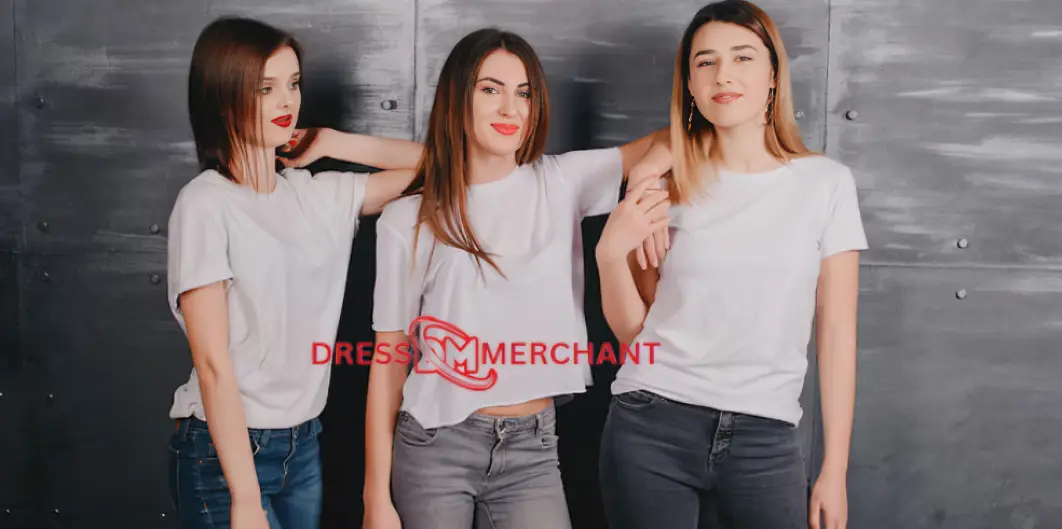Blank T-shirts For Screen Printing are essential for high-quality, customized apparel production. At Dress Merchant, a trusted apparel and garments buying agent, we source premium-grade blank tees perfect for screen printing, ensuring top-notch fabric, fit, and finish. As a reliable sourcing partner for global apparel manufacturers and exporters, we provide tailored solutions to meet your bulk garment needs with competitive pricing and timely delivery.
Thank you for reading this post, don't forget to subscribe!1. The Foundation of Creativity: Why Blank T-Shirts are Essential for Screen Printing
Blank T-shirts serve as the fundamental canvas for the vibrant world of screen printing. Far from being just plain garments, they are the starting point for countless creative expressions, brand identities, and personalized statements. Without a high-quality blank, even the most intricate and well-executed screen print can fall flat.
Their importance extends beyond mere fabric; they represent the potential for transformation, turning a simple piece of clothing into a wearable work of art or a powerful marketing tool. The right blank T-shirt ensures that the ink adheres properly, colors pop, and the final product not only looks good but also feels comfortable and lasts through countless washes.
This foundational role makes selecting the right blank a critical decision in the screen printing process, influencing everything from print quality and durability to customer satisfaction.
1.1 The Unsung Hero: Why Quality Blanks Matter More Than You Think
The quality of a blank T-shirt directly impacts the success of a screen printing project, yet its importance is often underestimated. A high-quality blank provides a smooth, consistent surface that allows for optimal ink absorption and vibrant color reproduction. Fabrics with loose weaves, inconsistencies in texture, or an abundance of stray fibers can lead to blotchy prints, uneven ink distribution, and a generally unprofessional appearance.
Furthermore, the durability of the blank directly affects the longevity of the printed design. A cheap, low-quality T-shirt might shrink excessively, warp, or pill after a few washes, diminishing the appeal of even the best screen print. Investing in superior blanks ensures that the finished product not only looks impressive upon creation but also maintains its integrity and visual appeal over time, reflecting positively on the print shop or brand.
1.2 Versatility in Design: Adapting to Diverse Artistic Visions
Blank T-shirts offer unparalleled versatility, making them adaptable to an incredibly diverse range of artistic visions and design aesthetics. From minimalist logos to complex multi-color illustrations, the blank canvas allows for boundless creativity. Different fabric blends—like 100% cotton, cotton-polyester blends, or tri-blends—each present unique characteristics that can complement or enhance specific print styles.
For instance, 100% cotton is ideal for classic, crisp prints, while blends might offer a softer feel and a more vintage look. The availability of various cuts and styles—crew neck, V-neck, long sleeve, short sleeve, tanks, and hoodies—further expands the creative possibilities, allowing screen printers to cater to a wide demographic and a multitude of fashion preferences. This inherent adaptability is what makes blank T-shirts the go-to choice for custom apparel.
1.3 Cost-Effectiveness: Maximizing Profit Margins for Businesses
For businesses involved in custom apparel, brand merchandise, or promotional products, the cost-effectiveness of blank T-shirts is a significant factor in maximizing profit margins. Purchasing blank T-shirts in bulk from reputable wholesalers significantly reduces the per-unit cost, allowing businesses to offer competitive pricing to their customers while maintaining healthy profitability.
This bulk purchasing power, combined with efficient screen printing processes, creates a scalable business model. Furthermore, the wide availability and consistent supply of popular blank styles mean that businesses can reliably source their materials without significant delays or price fluctuations, enabling them to meet demand and maintain consistent production schedules. The ability to control material costs is crucial for financial stability and growth in the competitive custom apparel market.
2. Unpacking the Fabric: Material Science Behind Blank T-Shirts
The material composition of a blank T-shirt is a pivotal factor influencing its feel, drape, printability, and durability. Understanding the various fabric types and their unique properties is essential for screen printers to select the optimal blank for a specific design and end-use. Each fiber, whether natural or synthetic, brings distinct advantages and challenges to the printing process, affecting everything from ink adhesion and curing to the final garment’s comfort and longevity.
Beyond just the raw material, the way the fabric is woven or knitted also plays a significant role, impacting its texture, stretch, and breathability. A deep dive into fabric science reveals why certain blanks perform better for specific printing techniques and why some materials are preferred for different applications, from athletic wear to casual fashion.
2.1 The Classic Choice: Understanding 100% Cotton Blanks
100% cotton T-shirts remain the perennial favorite for screen printing due to cotton’s natural absorbency and soft feel. Cotton fibers readily accept water-based and plastisol inks, resulting in vibrant, sharp prints with excellent opacity.
The breathability of cotton also makes these shirts comfortable for everyday wear. However, not all 100% cotton is created equal. Differences in cotton quality, such as ring-spun versus open-end cotton, significantly impact the fabric’s smoothness and durability. Ring-spun cotton, made from longer, finer fibers, results in a softer, more tightly woven fabric that provides a superior printing surface and less shrinkage.
Open-end cotton, while more economical, can be coarser and more prone to pilling. Despite its advantages, 100% cotton can be prone to shrinking if not pre-shrunk, and some darker cottons may require an underbase for bright prints.
2.2 Blending for Performance: The Benefits of Cotton-Polyester Mixes
Cotton-polyester blends offer a compelling combination of the best attributes of both fibers, resulting in a versatile blank T-shirt that addresses some of the limitations of 100% cotton. The addition of polyester enhances durability, reduces shrinkage, and improves wrinkle resistance, making these shirts easier to care for and more resilient over time. Polyester also contributes to better moisture-wicking properties, which is beneficial for activewear or warmer climates.
From a printing perspective, cotton-polyester blends can offer a slightly different print surface, often resulting in a softer, more vintage-looking print, especially with water-based inks that tend to sink into the fabric more. However, achieving bright, opaque prints on darker polyester-blend shirts might require specific ink types or printing techniques, as polyester can be more resistant to ink absorption than pure cotton.
2.3 The Tri-Blend Revolution: Comfort, Drape, and Unique Aesthetics
Tri-blend T-shirts, typically composed of polyester, cotton, and rayon, represent a modern innovation in blank apparel, offering an unparalleled level of softness, drape, and vintage aesthetic. The combination of these three fibers creates a unique fabric with superior comfort and a lightweight feel that drapes beautifully on the body. Rayon contributes to the luxurious softness and adds a slight sheen, while polyester provides durability and shape retention, and cotton maintains a natural feel and printability.
For screen printing, tri-blends offer a distinct look where the print often appears slightly distressed or faded, blending seamlessly with the fabric’s natural texture. This characteristic is highly sought after for fashion-forward designs and vintage-inspired graphics. Due to their synthetic content, some tri-blends may require specific ink types or lower curing temperatures to prevent dye migration, but the aesthetic payoff is often worth the consideration.
2.4 Beyond the Basics: Exploring Specialty Fabrics like Rayon and Modal
While cotton, polyester, and their blends dominate the blank T-shirt market, a variety of specialty fabrics offer unique properties for specific applications. Rayon, a semi-synthetic fiber derived from wood pulp, is known for its exceptional softness, excellent drape, and silky feel, often used in fashion-forward garments. It absorbs dyes well, leading to vibrant colors, and its breathable nature makes it comfortable.
Modal, a type of rayon made from beechwood, takes these qualities a step further, offering even greater softness and resistance to shrinkage and fading. Both rayon and modal can be excellent choices for screen printing, particularly when a luxurious feel and a fluid drape are desired. They tend to accept water-based inks well, producing soft-hand prints that integrate beautifully with the fabric.
Understanding these less common but highly valuable materials allows screen printers to expand their offerings and cater to niche markets seeking premium comfort and aesthetics.
3. The Art of the Fit: Styles and Silhouettes in Blank T-Shirts
The cut and fit of a blank T-shirt are as crucial as its fabric composition in determining the final aesthetic and appeal of a screen-printed garment. Different styles cater to various body types, fashion trends, and target demographics, impacting how a design is perceived and worn. A well-chosen silhouette can enhance the screen-printed graphic, making it look more cohesive and professional, while a mismatched fit can detract from even the best design.
From classic utilitarian cuts to modern, fashion-forward slim fits, understanding the nuances of T-shirt styles allows screen printers to curate a collection that appeals to a broad audience and effectively translates their creative vision into wearable art. The “fit” isn’t just about size; it’s about the garment’s overall shape, drape, and how it interacts with the wearer’s body.
3.1 The Enduring Appeal of the Standard Fit: Versatility for Every Body
The standard or “regular” fit T-shirt is a timeless classic, offering a relaxed and comfortable silhouette that appeals to a wide demographic. This cut provides ample room in the chest, waist, and sleeves without being overly baggy, making it incredibly versatile for various body types. The standard fit is a safe and reliable choice for bulk orders, promotional items, and general merchandise, as it offers broad appeal and minimizes the risk of sizing issues.
For screen printing, its generous surface area provides an excellent canvas for large designs, logos, and intricate artwork. The enduring popularity of the standard fit lies in its universal comfort and adaptability, ensuring that printed designs are showcased on a garment that many people will find easy to wear and appreciate.
3.2 Sleek and Modern: Embracing the Slim and Fashion Fit
The slim fit, often referred to as “fashion fit” or “retail fit,” represents a contemporary evolution in T-shirt design, offering a more tailored and contoured silhouette. These shirts are cut closer to the body, with narrower sleeves and a tapered waist, providing a more modern and stylish appearance. Slim-fit T-shirts are popular among younger demographics and those who prefer a more fashionable, form-fitting look.
For screen printers, these blanks can elevate the perceived value of a design, giving it a retail-ready aesthetic. However, the smaller print area and the contours of the garment may require more precise design placement and sometimes limit the size of the print. The sleekness of the slim fit complements minimalist designs, typography, and graphics that aim for a sophisticated, contemporary feel.
3.3 Beyond the Basic: Exploring Athletic and Oversized Styles
Beyond the standard and slim fits, a variety of specialized T-shirt styles cater to niche markets and specific aesthetic preferences. Athletic fit T-shirts are designed for performance, often featuring moisture-wicking fabrics and cuts that allow for maximum range of motion. These shirts might have raglan sleeves or a more tapered body to reduce bulk, making them ideal for sports teams, fitness brands, or outdoor enthusiasts.
On the other end of the spectrum, oversized or “relaxed fit” T-shirts are gaining popularity, offering a baggy, streetwear-inspired look. These styles provide a vast canvas for large, bold graphics and offer a distinct fashion statement. Each of these specialized fits requires a thoughtful approach to design placement and size to ensure the screen print complements the garment’s intended purpose and aesthetic.
4. The Screen Printer’s Toolkit: Essential Characteristics of Ideal Blanks
For screen printers, not all blank T-shirts are created equal. The ideal blank possesses a specific set of characteristics that streamline the printing process, ensure optimal print quality, and contribute to the longevity and appeal of the finished product. These features go beyond just fabric type and fit; they encompass the garment’s construction, consistency, and overall suitability for the demanding nature of screen printing.
Understanding these essential attributes allows printers to select blanks that minimize errors, reduce waste, and ultimately deliver superior results to their clients, solidifying their reputation for quality and craftsmanship. The blank T-shirt acts as the foundation upon which the printer builds, and a strong foundation is paramount for success.
4.1 Smoothness and Evenness: The Perfect Canvas for Ink Adhesion
The surface of a blank T-shirt is paramount for achieving crisp, high-definition screen prints. Ideal blanks feature a smooth, even surface devoid of excessive lint, loose fibers, or inconsistencies in the weave. A coarse or uneven fabric can lead to ink bleeding, feathered edges, and a generally fuzzy appearance, compromising the clarity and detail of the design.
When the fabric is consistently smooth, the squeegee can lay down an even layer of ink, ensuring complete coverage and vibrant color saturation. This smooth canvas is particularly critical for intricate designs, fine lines, and halftones, where every detail matters. High-quality blanks often use ring-spun cotton or tightly knit blends to achieve this desirable surface, making the printer’s job significantly easier and the final print visually superior.
4.2 Minimal Shrinkage and Colorfastness: Ensuring Longevity and Consistency
One of the most frustrating issues for both screen printers and end-users is significant garment shrinkage after washing. Ideal blank T-shirts are pre-shrunk or designed to minimize shrinkage, ensuring that the printed design retains its intended size and shape. Uncontrolled shrinkage can distort the print, making it appear warped or disproportionate. Equally important is colorfastness.
High-quality blanks are dyed using stable pigments that resist fading or bleeding, even after multiple washes. This ensures that the base color of the T-shirt remains true, preventing it from dulling the print or bleeding onto other garments. For dark-colored shirts, good colorfastness also prevents dye migration, where the garment’s dye leeches into lighter-colored inks during the curing process, leading to discoloration.
4.3 Consistent Sizing and Construction: Streamlining Production
Consistency in sizing and garment construction is a non-negotiable trait for ideal blank T-shirts, particularly for businesses handling large orders. Reputable blank apparel manufacturers adhere to strict quality control standards, ensuring that T-shirts of the same marked size truly are consistent in their dimensions. Inconsistent sizing can lead to customer complaints, return issues, and production delays as printers must sort through and potentially discard mis-sized garments.
Similarly, consistent construction—including even seams, well-finished hems, and properly aligned necklines—facilitates efficient loading onto platens and smooth printing. Deviations in construction can cause garments to buckle or shift during printing, leading to misprints and wasted product. Reliability in sizing and construction allows screen printers to maintain a high level of efficiency and product quality.
5. Navigating the Market: Sourcing and Selecting Your Blank T-Shirt Suppliers
Choosing the right blank T-shirt supplier is a critical business decision for any screen printer or custom apparel company. The supplier directly impacts the quality, cost, and availability of the foundational product, influencing everything from production timelines to customer satisfaction. A reliable supplier offers consistent quality, competitive pricing, a wide selection of styles and colors, and efficient shipping.
The process of sourcing involves more than just finding the cheapest option; it requires due diligence, a clear understanding of your specific needs, and a commitment to building long-term relationships that support your business growth. Identifying and partnering with the best suppliers can be a significant competitive advantage in the custom apparel industry.
5.1 The Power of Wholesale: Advantages of Bulk Purchasing
Purchasing blank T-shirts wholesale offers substantial advantages for screen printing businesses, primarily in terms of cost savings and inventory management. Wholesale pricing significantly reduces the per-unit cost compared to retail purchases, directly increasing profit margins. This bulk purchasing power allows businesses to invest less capital per garment while maintaining a healthy stock level.
Beyond cost, wholesale suppliers typically offer a much wider variety of styles, colors, and sizes that might not be available through retail channels. Buying in bulk also reduces the frequency of orders, minimizing shipping costs and streamlining the supply chain. Establishing a relationship with a wholesale distributor ensures a consistent supply of blanks, which is crucial for fulfilling large orders and maintaining production schedules without interruption.
5.2 Quality Control and Consistency: What to Look for in a Supplier
When evaluating blank T-shirt suppliers, prioritizing quality control and consistency is paramount. A reputable supplier will have rigorous internal quality checks to ensure that their products meet specific standards. This includes consistent fabric weight, accurate sizing across different production batches, uniform stitching, and reliable colorfastness.
Requesting samples before placing large orders is a vital step to assess the physical quality of the blanks, their feel, and how they react to your printing process. Look for suppliers with transparent communication about their manufacturing processes and quality assurance protocols. Consistent quality minimizes misprints, reduces waste, and builds customer trust, ensuring that every garment you print meets your professional standards.
5.3 Navigating Lead Times and Shipping: Logistics for Seamless Operations
Efficient logistics are a cornerstone of a successful screen printing business, and a blank T-shirt supplier’s lead times and shipping capabilities play a crucial role. Before committing to a supplier, understand their typical turnaround times for order processing and delivery. Factors like inventory levels, proximity of warehouses, and available shipping options (standard, expedited) will impact how quickly you receive your blanks.
Consider the supplier’s reliability in meeting quoted delivery dates, as delays can disrupt your production schedule and impact client deadlines. Some suppliers offer drop-shipping services or have multiple distribution centers, which can further optimize delivery times and reduce shipping costs. A supplier that can consistently deliver the right products on time is invaluable for maintaining smooth and predictable operations.
6. Pre-Press Perfection: Preparing Blank T-Shirts for Screen Printing
The quality of a screen print isn’t solely dependent on the blank T-shirt itself or the printing technique; proper pre-press preparation of the blank is equally critical. This often-overlooked stage can significantly impact ink adhesion, print clarity, and the overall longevity of the design. Neglecting pre-press steps can lead to common printing issues like pinholes, ink bleed, and premature print degradation.
From proper storage to pre-treating certain fabrics, a meticulous approach to preparing the blank canvas ensures that the T-shirt is in optimal condition to receive the ink, allowing the screen printer to achieve the best possible results and deliver a professional-grade product.
6.1 Unboxing and Inspection: Your First Line of Defense Against Flaws
Upon receiving a shipment of blank T-shirts, the very first step in pre-press preparation is a thorough unboxing and inspection. This is your primary opportunity to identify any manufacturing defects, inconsistencies in sizing, or shipping damage before the garments enter your production line. Look for loose threads, uneven seams, stains, holes, or color discrepancies.
While it’s impractical to inspect every single shirt in a large batch, conducting random spot checks on a significant percentage of the order can catch widespread issues. Early detection allows you to address problems with your supplier promptly, minimizing waste and preventing defective garments from being printed, which would result in lost time and materials.
6.2 Pre-Shrinking and Pre-Washing: When and Why it Matters
The decision to pre-shrink or pre-wash blank T-shirts before screen printing depends on the fabric type, desired print outcome, and the specific ink system being used. 100% cotton garments are notoriously prone to shrinkage, and pre-washing can mitigate this by allowing the garment to shrink before printing, ensuring the print remains proportionate after the customer washes it.
This is particularly important for designs that are precise or wrap around the garment. Pre-washing can also remove sizing agents, lint, or fabric softeners that might interfere with ink adhesion. For water-based inks, pre-washing can sometimes improve absorption and vibrancy. However, pre-washing adds a significant step to the production process, including drying, and may not be necessary for all projects, especially with pre-shrunk blanks or plastisol inks that are less affected by fabric additives.
6.3 Flattening and De-Wrinkling: Creating a Smooth Printing Surface
For optimal screen printing results, the blank T-shirt must present a perfectly flat and smooth surface to the screen and squeegee. Wrinkles, creases, or bunched-up fabric can lead to uneven ink deposits, skipped areas, and a blotchy print. Before loading the T-shirt onto the platen, it’s essential to flatten it thoroughly. This can be achieved by stretching the garment gently, pulling it taut, and smoothing out any wrinkles by hand.
For stubborn creases, a heat press can be used for a quick pass to flatten the fabric, especially around the print area. Some printers also use platen adhesive to hold the shirt firmly in place, preventing shifting and wrinkling during the printing process. A smooth surface ensures consistent ink application and crisp details.
7. Ink Meets Fabric: Optimizing Screen Printing on Different Blanks
The interaction between ink and fabric is the heart of screen printing, and optimizing this relationship is key to achieving high-quality, durable prints. Different blank T-shirt materials react uniquely to various ink types and printing techniques, necessitating an understanding of these nuances. What works perfectly on 100% cotton may not yield the same results on a polyester blend, and vice versa.
Expert screen printers possess the knowledge to select the right ink system, adjust their printing parameters, and employ specific techniques to ensure vibrant colors, excellent adhesion, and a soft hand-feel across the wide spectrum of blank T-shirt options. This optimization ensures that the final product not only looks good but also stands the test of time and wear.
7.1 Plastisol Inks: The Workhorse for Vibrant Prints on Cotton
Plastisol inks are the most widely used type of ink in screen printing, particularly for 100% cotton blank T-shirts, due to their versatility, opacity, and durability. Composed of PVC resins and plasticizers, plastisol inks sit on top of the fabric rather than soaking into it, resulting in incredibly vibrant colors and excellent opacity, even on dark garments.
They are easy to work with, have a long shelf life, and do not dry in the screen, which makes them ideal for multi-color jobs. When properly cured with heat (typically 320°F / 160°C), plastisol prints are extremely durable, flexible, and resistant to cracking, fading, and washing. While they offer a slightly thicker hand-feel compared to water-based inks, advancements in plastisol formulations have led to softer, more pliable options, making them the preferred choice for many screen printers targeting crisp, long-lasting prints on cotton blanks.
7.2 Water-Based Inks: Achieving a Soft Hand on Natural Fibers
Water-based inks offer a distinct advantage for those seeking an incredibly soft-hand print that becomes part of the fabric itself, making them an excellent choice for natural fiber blank T-shirts like 100% cotton or certain tri-blends. Unlike plastisol, water-based inks soak into the garment’s fibers, resulting in a breathable print that doesn’t crack or peel.
They are environmentally friendlier, emitting fewer volatile organic compounds (VOCs). While they generally provide less opacity than plastisol, especially on dark garments (often requiring multiple passes or a discharge underbase), their ability to integrate with the fabric creates a vintage or sublimated look that is highly desirable for fashion apparel.
Curing water-based inks typically requires more precise temperature and humidity control, but the luxurious feel and eco-conscious appeal make them a popular option for specific blank T-shirt applications.
7.3 Discharge Printing: Removing Dye for Unique Effects on Cotton
Discharge printing is a specialized screen printing technique that involves using an additive in the ink to remove the existing dye from a reactive-dyed blank T-shirt, replacing it with the desired ink color. This method is primarily used on 100% cotton garments that have been dyed with reactive dyes (not all cottons are suitable). The result is an incredibly soft-hand print where the image feels like part of the fabric, virtually indistinguishable from the surrounding material.
Discharge prints are known for their vibrant, “no-feel” appearance, making them ideal for high-end fashion and comfortable apparel. The color of the print is determined by the ink color mixed with the discharge agent, but the brightness can be influenced by the original garment’s dye.
While it requires specific safety precautions due to the chemicals involved, discharge printing offers a unique aesthetic that cannot be achieved with traditional plastisol or water-based inks, especially on dark blank T-shirts.
7.4 Polyester and Blends: Navigating Dye Migration and Print Challenges
Screen printing on polyester and cotton-polyester blend blank T-shirts presents unique challenges, primarily due to the phenomenon of dye migration. Polyester dyes can “migrate” or bleed into the lighter-colored plastisol inks during the curing process, resulting in a reddish or pinkish hue in the print. To combat this, specialized low-bleed plastisol inks or dye-blocking underbases are essential. These inks are formulated to cure at lower temperatures or contain agents that prevent the polyester dye from interacting with the printed ink.
Additionally, the smoother, less absorbent surface of polyester can sometimes make ink adhesion more challenging, requiring higher mesh counts or specific ink additives. Despite these complexities, printing on polyester and blends allows for garments with enhanced durability, moisture-icking properties, and reduced shrinkage, expanding the range of functional and performance-oriented blank T-shirt offerings.
8. Beyond the Basic Tee: Specialty Blanks and Niche Markets
While the standard crew neck T-shirt remains a staple, the blank apparel market offers an expansive array of specialty garments designed to cater to niche markets, specific functional needs, or unique fashion trends. Exploring these diverse options allows screen printers to expand their service offerings, attract new client segments, and deliver highly customized solutions that go beyond the conventional.
From athletic wear engineered for performance to eco-friendly options for conscious consumers, understanding these specialty blanks opens up new creative and commercial possibilities, allowing printers to differentiate themselves in a competitive landscape. The ability to source and print on these specialized blanks positions a screen printing business as a versatile and adaptable partner.
8.1 Performance Blanks: Catering to Athletes and Active Lifestyles
Performance blank T-shirts are engineered with advanced fabric technologies to meet the demands of athletes, fitness enthusiasts, and those with active lifestyles. These garments are typically made from moisture-wicking polyester or blends that draw sweat away from the body, keeping the wearer dry and comfortable.
They often feature anti-odor properties, four-way stretch, and breathable designs, making them ideal for sports teams, gyms, running clubs, and outdoor apparel brands. Screen printing on performance blanks requires specific considerations due to their synthetic composition, often necessitating low-bleed inks to prevent dye migration and careful curing to avoid scorching the fabric.
Offering performance blanks allows screen printers to tap into the booming athleisure market and provide high-quality, functional apparel solutions.
8.2 Eco-Friendly Options: Sustainable Blanks for Conscious Brands
As environmental consciousness grows, the demand for eco-friendly blank T-shirts is steadily increasing. These sustainable options cater to brands and consumers who prioritize ethical sourcing, reduced environmental impact, and responsible manufacturing practices.
Eco-friendly blanks can be made from a variety of materials, including organic cotton (grown without harmful pesticides or synthetic fertilizers), recycled polyester (derived from plastic bottles), or blends incorporating sustainable fibers like bamboo or hemp. Printing on these blanks often aligns with brands promoting a sustainable message, requiring printers to consider using water-based, phthalate-free, or eco-friendly inks to maintain consistency with the garment’s values.
Offering sustainable blanks allows screen printers to appeal to a growing market segment and demonstrate a commitment to environmental responsibility.
8.3 Fashion-Forward Blanks: Differentiating with Unique Cuts and Textures
The fashion industry continually evolves, and blank T-shirt manufacturers respond with an array of fashion-forward styles designed to stand out. These blanks go beyond basic cuts, incorporating unique features such as raw edges, dropped shoulders, extended lengths, oversized fits, or distressed textures. Fabrics might include slub cotton for a textured look, triblends for superior drape, or garment-dyed options for a vintage feel.
These blanks are ideal for fashion brands, boutique clothing lines, and designers looking to create apparel with a distinct aesthetic and elevated retail appeal. Screen printing on fashion-forward blanks requires an understanding of how the design interacts with the garment’s unique cut and texture, often emphasizing minimalist designs or those that enhance the garment’s inherent style rather than overpowering it.
9. Quality Control and Post-Production: Ensuring a Flawless Final Product
The screen printing process doesn’t end when the ink is laid down. A comprehensive approach to quality control and diligent post-production procedures are essential to deliver a flawless final product that meets both the client’s expectations and the printer’s professional standards. These steps are crucial for identifying and rectifying any imperfections, ensuring the longevity of the print, and preparing the garments for delivery.
Neglecting these final stages can undermine all the effort put into sourcing quality blanks and executing a perfect print, potentially leading to customer dissatisfaction and a damaged reputation. A robust post-production process is the ultimate assurance of quality.
9.1 The Critical Cure: Ensuring Ink Durability and Washability
Proper ink curing is arguably the most critical step in the screen printing process, directly impacting the durability and washability of the print. Whether using plastisol, water-based, or discharge inks, each requires specific temperature and dwell time parameters to fully cure. Under-cured ink will be soft, peel, crack, or wash out prematurely, leading to a compromised product.
Over-curing can scorch the fabric, especially on polyester blends, or make the print brittle. Screen printers must use accurate temperature measurement tools, such as temperature guns or donut probes, and ensure consistent heat distribution in their curing units. Achieving the “critical cure” transforms liquid ink into a durable, integrated part of the blank T-shirt, ensuring the design withstands countless washes and wears.
9.2 Final Inspection: Catching Imperfections Before Delivery
Before packaging and delivery, every screen-printed blank T-shirt should undergo a meticulous final inspection. This critical quality control step is the last opportunity to identify any imperfections or errors that may have occurred during the printing process. Inspectors should look for misprints, off-registration, ink smudges, pinholes, lint trapped in the ink, or any other print defects.
They should also check for garment flaws such as holes, stains, or loose threads that might have been missed during the initial unboxing. While it can be time-consuming for large orders, a thorough final inspection prevents defective products from reaching the customer, saving on costly returns, reprints, and reputational damage. It’s a testament to a print shop’s commitment to quality.
9.3 Folding, Tagging, and Packaging: Presentation Matters
The presentation of the finished screen-printed blank T-shirts is the final touch that elevates the perceived value of the product and contributes to customer satisfaction. Proper folding ensures that the garments arrive neatly and wrinkle-free, ready for display or wear.
Many businesses also opt for custom tagging, replacing the blank T-shirt’s original tag with their own branded label, which reinforces their brand identity and provides a professional, retail-ready finish. Packaging also plays a role; clear poly bags protect the garments from dust and moisture during transit and storage.
For some clients, individual bagging may be required. Thoughtful folding, precise tagging, and protective packaging collectively contribute to a positive unboxing experience, reinforcing the quality and care put into each garment.
10. The Business Edge: Marketing and Selling Screen-Printed Blank T-Shirts
Once you have mastered the art of screen printing on blank T-shirts, the next crucial step is effectively marketing and selling your finished products. The quality of your blanks and prints is paramount, but without a strategic approach to reaching your target audience, even the best apparel can go unnoticed. This involves understanding your market, showcasing your capabilities, leveraging digital platforms, and building strong client relationships.
Success in the custom apparel industry hinges on both production excellence and astute business development, transforming your craftsmanship into profitable ventures. By understanding these market dynamics and employing effective strategies, you can position your screen-printed blank T-shirts for commercial success.
10.1 Building a Strong Portfolio: Showcasing Your Expertise
A compelling portfolio is your most powerful marketing tool, demonstrating your screen printing capabilities and the quality of your work on various blank T-shirts. This portfolio should feature high-resolution images of your best prints on a diverse range of garments—different colors, styles, and fabric types. Include examples of complex designs, multi-color prints, and specialty ink applications to highlight your versatility.
Showcase how well your prints lay on different blanks, from soft tri-blends to durable 100% cotton. Beyond just photos, consider including testimonials from satisfied clients and, where appropriate, case studies that illustrate your problem-solving abilities and creative solutions. A well-curated portfolio builds trust and visually communicates your expertise to potential clients.
10.2 Understanding Your Niche: Targeting the Right Audience
Identifying and understanding your target niche is fundamental to effective marketing. Are you specializing in band merchandise, corporate uniforms, sports team apparel, or fashion-forward streetwear? Each niche has distinct needs, aesthetic preferences, and budget considerations. Once you define your niche, you can tailor your marketing messages, blank T-shirt offerings, and design services to resonate specifically with that audience.
For example, if you target athletic teams, you’ll emphasize performance blanks and durable inks. If your focus is fashion boutiques, you’ll highlight soft-hand prints on premium, fashion-forward blanks. A clear understanding of your niche allows for more focused and efficient marketing efforts, leading to higher conversion rates and stronger client relationships.
10.3 Leveraging Online Presence: Websites, Social Media, and E-commerce
In today’s digital age, a robust online presence is indispensable for marketing screen-printed blank T-shirts. A professional website serves as your digital storefront and portfolio, providing essential information about your services, pricing, and contact details. Optimizing your website for search engines (SEO) can help potential clients find you organically. Social media platforms like Instagram, Facebook, and Pinterest are excellent for visually showcasing your work, engaging with your audience, and building a community around your brand.
E-commerce capabilities, whether through your own website or platforms like Etsy, allow you to directly sell pre-designed apparel or offer custom order options. Consistently updated content, behind-the-scenes glimpses, and customer interactions on these platforms can significantly expand your reach and drive sales.
10.4 Pricing Strategies: Value, Profitability, and Competitiveness
Developing effective pricing strategies is crucial for the financial health of your screen printing business. Your pricing must cover your material costs (including blank T-shirts), labor, overhead, and allow for a healthy profit margin, while remaining competitive within the market. Consider various factors: the type and quality of the blank T-shirt, the complexity of the design, the number of colors, the quantity ordered, and the turnaround time.
Offering tiered pricing for different order volumes can incentivize larger purchases. Beyond cost-plus pricing, consider value-based pricing, where you charge based on the perceived value and quality of your work and the blanks you use. Regularly reviewing market rates and competitor pricing helps ensure your strategies are both profitable and attractive to clients.
Conclusion: Blank T-shirts For Screen Printing
At Dress Merchant, we understand that blank T-shirts for screen printing are not just basic apparel items—they are the foundation for creativity, branding, and retail success. As a trusted sourcing agent for apparel and garments manufacturers and exporters, we specialize in connecting global buyers with reliable suppliers who offer premium-quality blank T-shirts tailored for high-performance screen printing. Whether you’re launching a clothing brand, running a promotional campaign, or fulfilling wholesale orders, the right blank T-shirt can make all the difference. Partner with Dress Merchant to ensure you receive consistent quality, competitive pricing, and supply chain transparency—every step of the way.













